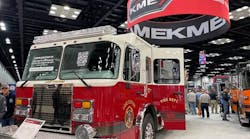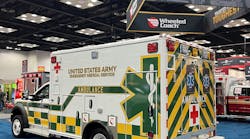Emergency braking is probably the least known and the most misunderstood operation that we perform behind the wheel of an emergency vehicle. Yet it is probably the most important factor in accident avoidance. But why?
When I teach an emergency vehicle operators' class, I will ask the question: "How many apparatus operators in this class have ever had to make a life-or-death emergency stop in the fire apparatus?" Inevitably, two or three operators will raise their hands, in a class of 30 operators. That means only about 10% or less of the operators that I have surveyed have ever had to make an emergency stop.
You will have a better understanding of this phenomenon if we examine events closely and in chronological order. We start at the fire station and find the apparatus backed into the bay, positioned similarly to a NASA rocket, ready to blast off. Then we add the next component, the apparatus operator in this case a new operator; the next alarm will be his first as an emergency vehicle operator.
The alarm sounds. He feels a rush of adrenaline as he mounts the apparatus and begins to respond. He is tentative, even nervous, as he responds at a respectable 20-30 mph. Time passes, he drives to a few more alarms, his confidence builds, his speed increases to 30-40 mph.
Then, his attitude changes. This fire apparatus driving is easy; people get out of his way when he turns on his lights and sirens (theoretically), the fire apparatus handles like a car, speed increases to 40-50 mph. A few months, then a few years go by.
As time passes, his confidence increases proportionally with speed and safety decreases, as complacency sets in. Now the driver has 10-15 years' driving experience, everyone gets out of his way and there is no situation that his driving abilities cannot handle. EXCEPT he has never had to make a sudden serious emergency stop.
Think about it. How many emergency stops have you had to make in your driving career? Have there been any? If you've never had to make a sudden stop, it now becomes much easier to respond at 50-60 mph. Maybe if apparatus operators had the awesome experience of bringing a 40,000-, 50,000- or 60,000-pound fire apparatus to an emergency stop at 50 mph, maybe they would not do 50 mph anymore. It becomes really easy in a modern fire apparatus to go really fast if you have never really had to stop.
How do you train operators on emergency braking procedures? First, you must identify the correct braking procedure. Three braking procedures come to mind.
The first emergency braking procedure is brake lockup. This occurs when the vehicle operator panics, holds the brake pedal to the floor in a vehicle not equipped with anti-lock brakes. When lockup occurs, the driver loses all operational and steering control. Why? It's a matter of physics. The driver's ability to keep the vehicle under control is a direct result of the friction between the vehicle's tires and the road surface.
When the brakes lock up, most of the friction is lost, causing the apparatus to skid out of control. If you are trying to steer when the brakes are locked, you will continue to straighten even if the wheels are turned to the left or right. Also with the brakes locked up, the friction is drastically reduced and it takes a much greater distance to stop. This braking procedure is obviously not the answer.
Next, we investigate the stab braking procedure. Stab braking occurs when the operator continually activates the brake with quick brake depressions or by pumping the brakes. With stab braking, there are multiple brake applications in a short period of time, thereby depleting the air supply for the brakes. This in turn could prematurely activate the maxi-brakes on the apparatus which could cause the brakes to lock up. Remember, under U.S. Department of Transportation (DOT) standards maxi-brakes on the apparatus will begin to activate at 60 psi. Although stab braking is better than locking up the brakes, the most efficient, safe, braking procedure is threshold braking.
Threshold braking is accomplished when the operator depresses the brake pedal until just prior to wheel lockup. Then, the operator is supposed to ease up on the brake pedal, keeping the tires rotating, which causes friction. When the operator is assured the wheels are moving, he again depresses the brake and keeps repeating the procedure until the vehicle comes to a complete stop.
This is a great procedure in theory; the reality is that the driver will probably panic, lock the wheels and lose control of the apparatus. The threshold braking procedure is the manual equivalent of anti-lock brakes. Although anti-lock brakes will be covered in a future column, there are several things you need to know about anti-lock brakes.
Anti-lock brakes are now required on most fire apparatus as per National Fire Protection Association (NFPA) 1901, the motorized fire apparatus standard (August 1996). Anti-lock brakes must be applied with steady, even pressure on the brake pedal and not the threshold braking procedure. It is imperative that the operator identify anti-lock brake equipped apparatus, prior to the movement of the apparatus.
I recently taught an emergency vehicle operators' course for a department that had a rescue truck that was 6 months old. Very few drivers knew that the rescue truck was equipped with anti-lock brakes and nobody understood how anti-lock brakes work. This was an accident waiting to happen.
Unfortunately, this situation is not unique to that fire department. I have said it before and I will say it again: in many cases we simply just do not know enough about what we are trying to do. With the introduction of electronics, technology and special systems, fire apparatus have become more complex and the fire service has fallen behind in understanding these complexities. What are the answers? Emergency braking training sessions and a driver's manual.
What preparation is necessary for emergency braking exercises? First and foremost, all apparatus must have successfully completed a DOT heavy-duty truck inspection and must be in top mechanical shape.
Next, find an appropriate location in which to conduct the test. We found a school with long, flat entrance and exit roads. We received permission to use the school facilities on a Sunday. We also arranged to have the emergency braking drill videotaped from two different angles.
We assigned a driver and one firefighter to be seated and belted in the cab. The first apparatus was sent down the entrance road attaining a speed of 50 mph. Upon passing the first set of traffic cones, the driver began to threshold brake. Drivers were given prior instruction that locking the brakes up was unacceptable and an unsafe act. Prior to the test, information had been compiled on the apparatus, including engine size, horsepower, transmission type, pump size, booster tank size and any auxiliary braking devices, if the apparatus was so equipped. Other information included vehicle height, overall length, width, weight and the wheelbase.
All the information and the distances needed to stop each of the apparatus were recorded. These measurements represent the total stopping distance for each of the apparatus included in the testing. Two emergency braking tests were completed on each of the seven apparatus that took part in these exercises. The average stopping distance was 154.83 feet, at an average speed of 48.91 mph, during the 14 emergency braking tests that were done.
The drivers who took part in this exercise now realize the limitations put on them by apparatus, their environment and even themselves. These limitations include, but are not limited to, the size of the vehicle, vehicle weight, speed, water surge, condition of the brakes and tires, road conditions, and the driver's ability and experience. Drivers also learned that these limitations are all interconnected and that they drastically affect the driver's ability to stop in an emergency.
What about the videotape of the emergency braking test? The tapes can be used for indoor driver training. Also, the tape could be invaluable in any future litigation. Although the test results are valid only for that date and time, they will prove to an outside third party that the department has some degree of competence and knowledge in the operation of its emergency vehicles.
I have another idea that may be helpful to apparatus manufacturers and apparatus operators. The apparatus manufacturer should provide a driver's manual. Unlike the owner's manual that is long, technical, confusing and usually locked in the chief's office, the driver's manual would be made available to all persons involved in the light maintenance and the operation of each vehicle. The driver's manual would be well organized, easy to understand and easy to read.
Why would the apparatus manufacturers look positively on this idea? It could save them hundreds or thousands of dollars on warranty work that could be avoided if the drivers had a better understanding of what they were trying to do. It would make the operation of emergency vehicles safer, which would benefit everyone. Anyone from the NFPA 1901 committee interested?
Michael Wilbur, a Firehouse® contributing editor, is an FDNY lieutenant in Ladder Company 27 in the Bronx and a firefighter in the Howells, NY, Fire Department. He is an adjunct instructor at the New York State Academy of Fire Science and the Orange County Fire Training Center. Wilbur has developed and presented emergency vehicle operator courses throughout the country and has consulted on a variety of fire apparatus issues.




